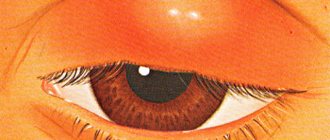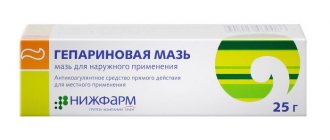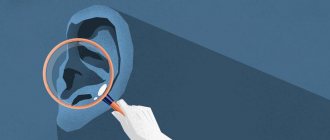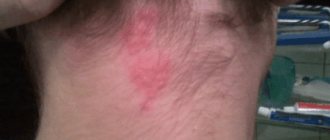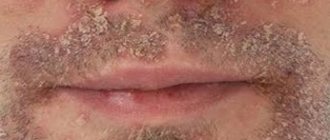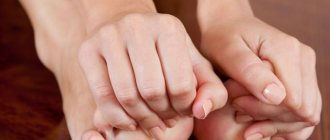Reasons for the appearance of a lump
Lipoma on the forehead - before and after surgery
A lump on the forehead does not appear without a reason - there is always an obvious or hidden negative factor that contributes to its occurrence:
- consequence of a blow, bruise, injury;
- allergic reaction due to an insect bite;
- neoplasm of a malignant and benign nature: lipoma, wart, cyst, fibroma, osteoma, etc.;
- purulent inflammation: boil, abscess, enlarged lymph node.
Bumps of traumatic origin appear on the head and forehead due to tissue swelling. They may change color (become blue, red) and become very painful when pressed. If the blow was noticeable enough, you need to see a neurologist to rule out a concussion and brain contusion.
When bitten by insects (wasp, bee, gadfly, etc.), a person may complain of pain at the site of skin damage, which gradually decreases. The lump develops in the form of an allergy to insect venom.
If there were no obvious impacts (trauma, bite), special attention must be paid to health. The presence of a painful, swollen lump, growth, or bulge that changes the skin tone may indicate an inflammatory process.
Types of hematoma
A hematoma forms after a strong blow that ruptures blood vessels and collects blood under the skin. The victim may experience mild pain, swelling, and a bluish-purple hue at the site of the injury.
A hematoma can be:
- Subcutaneously. Occurs when the forehead is bruised without damaging the surface of the epidermis. Post-concussion hemorrhage occurs under the skin.
- Intramuscularly. It is formed in the muscles of the head itself after injury.
After examining the hematoma, you can assess the condition of the victim. If only soft tissue is damaged, there is no need to see a doctor. A cause for concern is fragmentation at the site of the bruise or visual changes in the frontal bone, indicating a fracture. In this case, an urgent visit to a trauma surgeon is necessary.
Clinical picture
If after a blow a child begins to vomit, a concussion may occur.
If after a blow to the head an adult or child experiences:
- headache;
- darkening of the eyes;
- disorientation in space;
- nausea, dizziness;
- amnesia.
This indicates a concussion. The condition is classified as a mild head injury and often leaves no consequences. You should immediately seek medical help if, after a blow and a lump appears on your forehead, you experience:
- confusion of thoughts;
- convulsions;
- numbness of the limbs;
- lethargy, drowsiness;
- repeated bouts of vomiting;
- motor and speech disorders;
- stiffness of the neck muscles.
A growth on the skin after a bite can be identified by the presence of a red dot in the middle, as if from a syringe injection. It may not change color or may turn red, itch constantly, or increase in size.
Local inflammations have symptoms of boils (large pimples filled with purulent contents). If the pathological process is systemic in nature, enlarged lymph nodes appear in the form of oval swellings in the area of the back of the head. They are dense on palpation, painful, but have no signs of inflammation.
First aid for a forehead bruise
If the front of the head is bruised, correct and timely first aid will prevent the formation of a large hematoma. Immediately after the blow, the head must be examined. If the victim feels only mild pain at the site of the bruise, first aid can be provided independently, without the participation of medical personnel.
- Put the victim to bed, she should rest.
- If abrasions are noticeable, they should be treated with disinfectants (chlorhexidine or hydrogen peroxide). Anyone with bruises or deep injuries should be taken to a doctor and possibly stitched up.
- Bandage your head tightly.
- Provide a flow of fresh air into the room.
- Apply a cold compress to the bruised area. This could be ice wrapped in gauze, a metal spoon, or a handkerchief moistened with water. Keep it cold for 20 minutes and then take a break for half an hour. This procedure needs to be carried out for several days. Cold helps stop bleeding and reduce soft tissue swelling.
Every change in the victim’s condition for the worse is a reason to consult a doctor.
Tumors and inflammatory formations
An epidermal cyst is filled with fluid.
Balls, lumps, nodules, and bulges on the skin are formed due to clogging of sebaceous flows and hair follicles. They often do not cause acute pain and are characterized by slow growth.
Trichilemmal cyst
A small subcutaneous lump that appears on the crown, back of the head, in the temple area near the forehead. It is asymptomatic. It has a smooth surface and a dome shape. It is benign in nature and often recurs. Damages the hair follicle, forming a sac with liquid contents.
Epidermal cyst
It is benign in nature and consists of cells of the upper layers of the epidermis. It is distinguished by its small size (up to 5 cm) and pink tint. It may not go away for a long time.
Lipoma (wen)
Formation consisting of fat cells. It does not cause pain, but when it reaches a large size it can disturb the nerve endings, causing discomfort. Appears as a result of metabolic disorders, diseases of adipose tissue, and is inherited. In rare cases, it becomes malignant.
Atheroma
Atheroma is surgically removed.
A tumor-like formation localized on the scalp and face. It has clear contours and a mobile watery structure. It can become inflamed, causing fever, swelling, and redness of damaged tissues. Appears due to impaired outflow of the sebaceous glands, increased sweating, and dermatological diseases.
Hemangioma
A benign neoplasm prone to degeneration. Develops due to active proliferation of blood vessels in the scalp. It occurs in childhood in the first months of a child’s life.
Fibroma
A smooth compaction consisting of connective tissues, localized on any part of the body and mucous membranes. It does not cause pain, but can grow to large sizes. It occurs against the background of impaired metabolism, hormonal imbalance, and diabetes.
Inflammatory formations
A boil is characterized by an accumulation of pus.
If the lump on the forehead did not appear from a blow, when it is injured, infectious processes may develop, accompanied by an increase in temperature, pain, swelling, redness of the skin, and accumulation of pus. Common lumps that occur during inflammation include:
- Boils. Pathological process affecting hair follicles. It begins under the influence of staphylococci due to injuries, scratching, hypothermia, and poor hygiene. The round formation hurts when pressed, swells, turns red, and may have a white core from which purulent exudate mixed with blood oozes. With the frequent appearance of boils, furunculosis develops.
- Seborrheic dermatitis. Inflammation of the skin of a fungal nature with multiple white or yellow scales and numerous bumps. Develops under severe stress, living in an unfavorable ecological place, against the background of a genetic predisposition.
- Inflammation of the lymph nodes. It is observed after suffering from otitis, rubella, furunculosis, mycosis. During palpation, problem areas begin to hurt, become denser, and often appear symmetrically in the area behind the ear of the skull.
If lumps, nodules, or lumps in the forehead area periodically appear and disappear, the nature of their origin can only be determined by a doctor using laboratory or instrumental examination methods.
Liposarcoma - causes and types
Liposarcoma develops when certain mutations cause fat cells to grow uncontrollably. However, what the exact causes of this type of genetic disorder are has not yet been established.
- Local sarcoma.
The most common tumor type is well-differentiated liposarcoma, which is characterized by local malignancy. This means that the tumor can invade adjacent healthy tissue, but overall it has a very low propensity for distant metastasis. Among its most characteristic features is the fact that it has an extremely high tendency to relapse. - Liposarcoma of the mucous membrane.
Another type of liposarcoma is mucosal liposarcoma, which is now associated with round cell liposarcoma tumor. This soft tissue sarcoma, in turn, is known for the fact that it often leads to distant metastases.
In addition to those listed, there is also multiform liposarcoma, also called polymorphic. This is a fairly rare type of sarcoma and is known to be extremely metastatic. And undetermined liposarcoma, since it has the characteristics of all the previously mentioned types of liposarcoma.
Lump on a child's forehead
Most often, a bump on the forehead in children appears from a fall, bruise, or injury. The skin of babies is extremely sensitive to any damage, so the tumor grows quickly, increasing in size and changing color. If dangerous symptoms appear - nausea, loss of consciousness, vomiting, drowsiness - it is necessary to urgently hospitalize the victim.
During a difficult birth, infants develop a small formation filled with blood - a cephalohematoma. It appears as a result of a head injury and is removed surgically. This is not dangerous for a newborn.
Osteoma is a hard lump that grows slowly and occurs mainly in boys from 4 years of age. The seal is benign, has a spherical shape and clear boundaries. When pressed it does not hurt and does not move. Occurs due to injuries, congenital syphilis, heredity, rheumatism, gout.
In teenagers, wen often forms on the forehead due to increased sweating, poor hygiene, hormonal imbalance, and active work of the sebaceous glands.
What products to use for skin with closed comedones
Therapy with external agents includes the use of 2 types of agents:
Sunscreen with SPF based on mineral photo filters.
The sun's rays activate the sebaceous glands, which increases the number of blockages. The choice should be made in favor of physical photo filters - mineral screen .
Chemical photo filters are contraindicated. Their operating principle is based on converting the energy of UV rays into heat, which additionally activates the work of the sebaceous glands.
Examples:
Mineral cream SPF 30 with zinc DermaQuest based on micronized zinc oxide 18.6% is a universal sunscreen for all family members!
- Does not penetrate deep into the skin and does not cause blockages
- Safe and hypoallergenic
- Blocks up to 97% of sun rays
- In 2022, the composition is enriched with BlueLight filters against blue light
Tone cream SPF30 with zinc for the face DermaQuest - for those who do not like pale skin color. An analogue of mineral cream with SPF30, which contains pigments that give the skin a light tan.
CBD “Blue Light” face cream SPF 30 DermaQuest is a complete day cream with the functions of protecting the skin from UV rays and blue light.
- Indicated for sensitive, irritated and dry skin
- Nourishes and moisturizes
- Restores, heals and soothes irritated skin
The advantages of modern creams with SPF are not only photoprotection, but complete care products that do not require the application of additional creams in the morning.
Diagnostic methods
For numerous neoplasms, a biopsy is performed.
The therapist or dermatologist, after collecting an anamnesis and examining the problem area, refers the patient to blood and urine tests, which makes it possible to identify the presence of an inflammatory process in the body. It is also suggested to do:
- tumor marker test;
- X-ray of the skull and ENT organs;
- Ultrasound, MRI of the head.
If numerous lumps appear in the scalp area, a tissue biopsy is performed to identify cancer cells. Treatment measures and further actions depend entirely on the diagnostic results.
How to remove a bump on your forehead
If there is a bruise, ice is applied.
If a horn has grown on the forehead or in the head area due to a blow (injury), it is necessary to apply cold to the sore spot: wrap a couple of ice cubes in a napkin or clean cloth, but do not apply ice to the skin. Later use absorbable ointment or gel: Troxevasin, Arthrocol, Butadion, Bainvel. This will help reduce the size of the lump, get rid of the bruise and relieve pain. Heat cannot be used.
Benign formations are eliminated with laser or cryotherapy. They are not life-threatening, but can become inflamed if damaged. For lice bites, use lice ointments according to the instructions. If the damage is caused by mosquitoes, gadflies, or bees, take antihistamines and use compresses with Dimexide to relieve swelling.
Purulent processes require antibacterial, anti-inflammatory, and hormonal therapy. The patient takes systemic medications in a dosage calculated by a specialist. If the lymph nodes are enlarged, no special treatment is required. The main thing is not to heat them or rub them. When the immune system gets stronger, the nodes will shrink on their own and will no longer bother the patient.
If the lymph node becomes inflamed and suppuration begins, surgical intervention will be required.
Folk remedies
Fresh tomato juice is applied to boils.
At home, you can cope with mild inflammation using folk remedies. Pimples and boils are treated with a tomato mask. Tomatoes contain antioxidants that protect the skin, speed up its recovery, and prevent further tissue infection. Fresh tomato is cut into pieces and applied to the face for 20 minutes. Afterwards wash with warm water. The manipulation is repeated twice a day.
When itchy lumps and pimples appear, lemon juice is effective. Citric acid and vitamin C are beneficial for all types of epidermis. They exfoliate dead skin cells, dry the skin, and have an astringent property. Cut a circle from a fresh fruit and wipe your face with it 2-3 times a day.
Apple cider vinegar is successfully used for cystic formations of the sebaceous glands. Organic acids in the product kill bacteria that cause infection. A cotton swab is soaked in vinegar and applied to the problem area. Secure with a plaster or bandage and leave overnight. Repeat the procedure for 5-7 days. To enhance the effect, you can add a little honey to the vinegar.
If the lump is inflated, and there are no medications nearby, pain and inflammation are relieved by the following means:
- Plantain leaf. The fresh plant is crushed and applied to the diseased area as a compress.
- Potato. The tuber is grated, the resulting pulp is wrapped in gauze and applied to the seal for 30 minutes twice a day.
- Cabbage leaf. Pierce the leaf and knead to release the juice. Apply to the swelling on the forehead until the juice dries. A decoction is also made. The vegetable is boiled in milk, wrapped in a clean cloth and applied to the site of injury or inflammation.
If the bruise does not go away for a long time, ultraviolet irradiation will help. You need to expose your face to the sun, this will contribute to the rapid fading of the hematoma. The procedure should not last longer than 15 minutes.
Prevention measures
It is recommended to remove benign tumors while they are small.
Even an adult with good coordination of movements cannot completely avoid bumps, bruises and falls. However, you can reduce the likelihood of injury:
- do not leave a small child unattended on the sofa, bed, changing table;
- remove excess rugs and rugs, the edges of which can cause you to trip;
- hold on to the railing when going up/down stairs or steps;
- wear rubberized shoes in the winter season and ice;
- follow traffic rules;
- do not enter into conflict with inappropriate people;
- arrange the furniture in the apartment so that sharp corners do not stick out;
- do not drink alcohol in excessive quantities.
The main danger of nodes, growths, and compactions in the head area is the possibility of degeneration into malignant tumors. If the formation does not go away for a long time, it is better to consult a doctor and not resort to self-medication.
